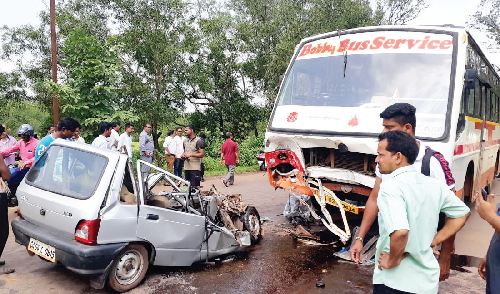Drunken driving, reckless speeding, and hit-and-run cases are not just legal offences, they are moral failings

Goa’s picturesque roads, winding through its scenic coastline and bustling town centres, should ideally symbolise freedom and mobility. Instead, they have become hotspots of drunken driving, reckless speeding, and hit-and-run accidents — transforming the dream of a drive along the state’s serene roads into a nightmare for many.
The recent replacement of the Indian Penal Code, 1860 (IPC), with the Bharatiya Nyaya Sanhita, 2023 (BNS), alongside key amendments to the Motor Vehicles Act, 1988, mark a pivotal shift in how road safety violations, particularly drunken driving and hit-and-run offences, are treated.
However, while legislative reforms play a role, the effectiveness of road safety measures depends on awareness, enforcement, and accountability.
A recurring menace
The numbers are alarming. Drunken driving remains a leading cause of fatal road accidents in Goa, particularly during tourist-heavy seasons. The Motor Vehicles Act, 1988 (amended in 2019), under Section 185, imposes strict penalties on those caught driving under the influence. The law prescribes imprisonment up to six months and/or a fine of ₹10,000 for first-time offenders, with harsher penalties for repeat violations. Despite these measures, enforcement remains lax, with offenders often walking free with minimal consequences.
Comparing global practices, zero-tolerance policies in countries like Sweden and Japan have demonstrated remarkable success. In contrast, Goa’s nightlife culture, coupled with weak enforcement, fosters an environment where drunken driving is treated as a trivial offence rather than a life-threatening hazard. Merely increasing penalties does not serve as a deterrent unless police action is proactive and systematic.
Hit-and-run accidents
Recent incidents have highlighted the alarming rise in hit-and-run cases across Goa. The Bharatiya Nyaya Sanhita, 2023, replaces Section 304-A of the IPC with Section 106(1) which increases punishment durations and focuses on hit and run cases as well as dealing with negligence by registered medical practitioners (JudiX, 2025).
Similarly, the erstwhile Section 279 (rash and negligent driving) is now covered under Section 281 of the BNS. While these provisions criminalise reckless and negligent driving, the larger issue remains whether the punishment is stringent enough to serve as a deterrent.
A hit-and-run accident victim faces not only physical injuries but also immense legal and financial hurdles. The escape of offenders from the scene adds layers of complexity to the victim’s pursuit of justice.
Goa’s roads have witnessed far too many instances where victims were left unattended, bleeding out while the guilty fled the scene. The time taken for medical assistance and police intervention often determines the difference between life and death.
Compensation for victims
Recognising the plight of hit-and-run victims, the Central Government introduced a state-sponsored scheme under which victims receive compensation of ₹50,000 for grievous injuries and ₹2,00,000 in case of death.
While this initiative provides a financial cushion, it is far from sufficient for victims who are permanently disabled or lose their ability to earn.
Additionally, the bureaucratic process of claiming compensation remains sluggish, riddled with administrative delays.
If a breadwinner is killed in a road accident, the loss is not merely financial, it devastates entire families. In such cases, justice can feel hollow, as the penalty imposed on the offender does little to compensate for the lifelong suffering endured by the victim’s family.
While laws exist, what is needed is a victim-centric approach that prioritises immediate financial relief and long-term support.
Holding vehicle owners ccountable
Another critical legislative shift is the liability of vehicle owners when they allow minors or unlicensed individuals to drive.
The Motor Vehicles Act, as amended in 2019, holds the owner accountable as an abettor if they knowingly permit such reckless behaviour. This is an essential measure, given the rising number of cases where parents or vehicle owners lend their vehicles without ensuring proper licensing.
Moreover, owners of vehicles involved in accidents, particularly hit-and-run cases, should face stricter penalties if they fail to cooperate with investigations. This would ensure that offenders do not exploit legal loopholes to escape accountability. In a society where roads are shared spaces, accountability must extend beyond the driver.
Beyond the legal complexities, it is essential to acknowledge the human toll of road accidents.
A victim of a hit-and-run faces an uphill battle, not just for recovery but for justice.
Many remain crippled for life, unable to work, and financially burdened.
Families struggle with medical expenses, lost wages, and emotional trauma. The pursuit of justice can be long and frustrating, especially when the legal system moves slowly.
In cases where the victim does not survive, no amount of compensation can fill the void left behind.
A child loses a parent, a family loses its primary breadwinner, and justice however delayed does little to reverse the irreparable loss.
Responsibility begins with us
Legislation can only go so far. The real change must come from society itself. Drunken driving, reckless speeding, and hit-and-run cases are not just legal offences, they are moral failings.
We, as a community, must hold ourselves accountable. If you drink, don’t drive. Choose public transport or a designated driver. If you witness an accident, don’t look away. Stay, assist, and call for help. If you lend your vehicle, ensure the driver is licensed and responsible.
Road safety is not just about laws, it is about the lives behind the statistics. It is time Goa chooses accountability over apathy, discipline over recklessness, and justice over negligence. The blood on the asphalt is a reminder that every reckless choice on the road can cost a life. The question is: Are we ready to change?